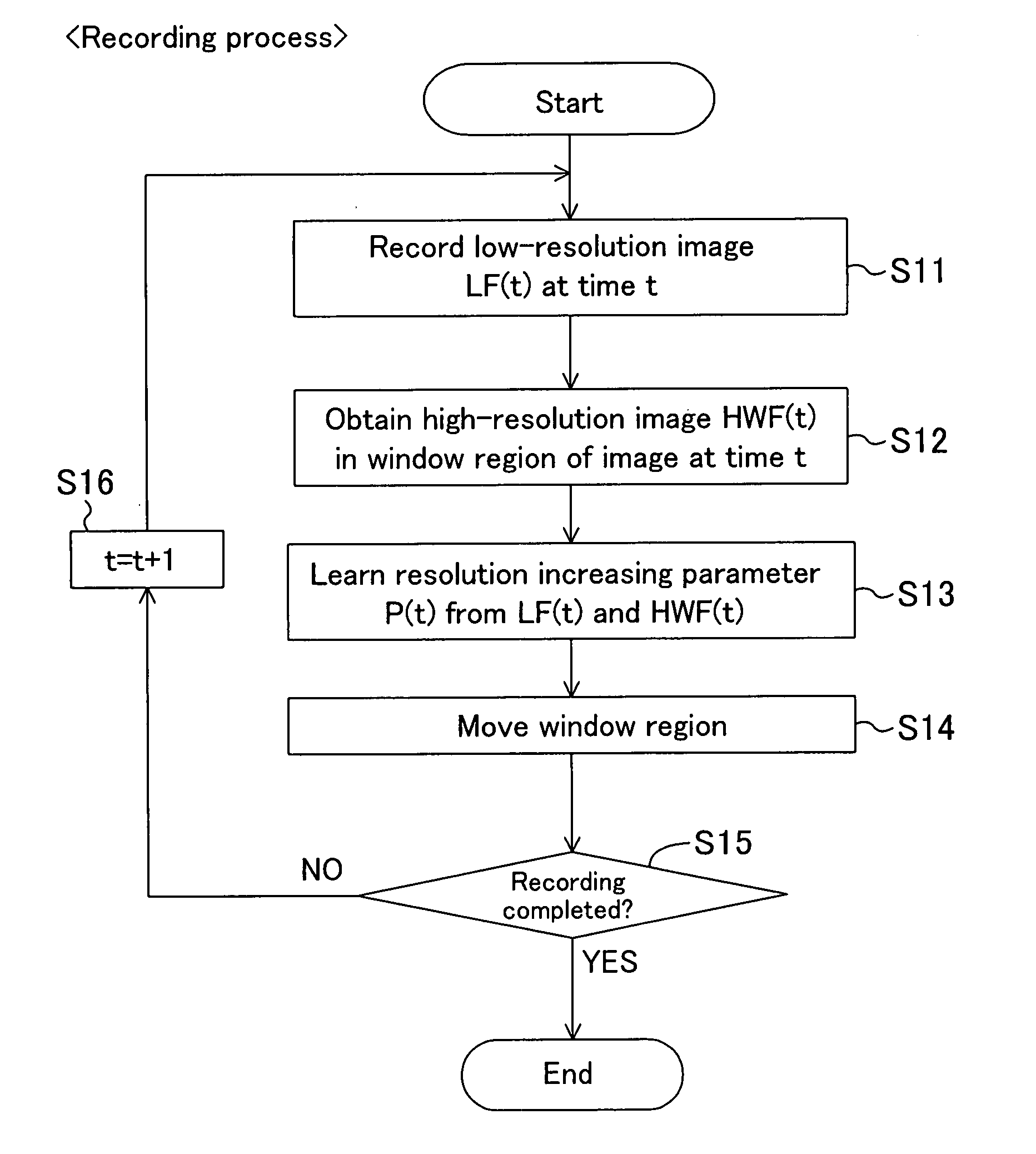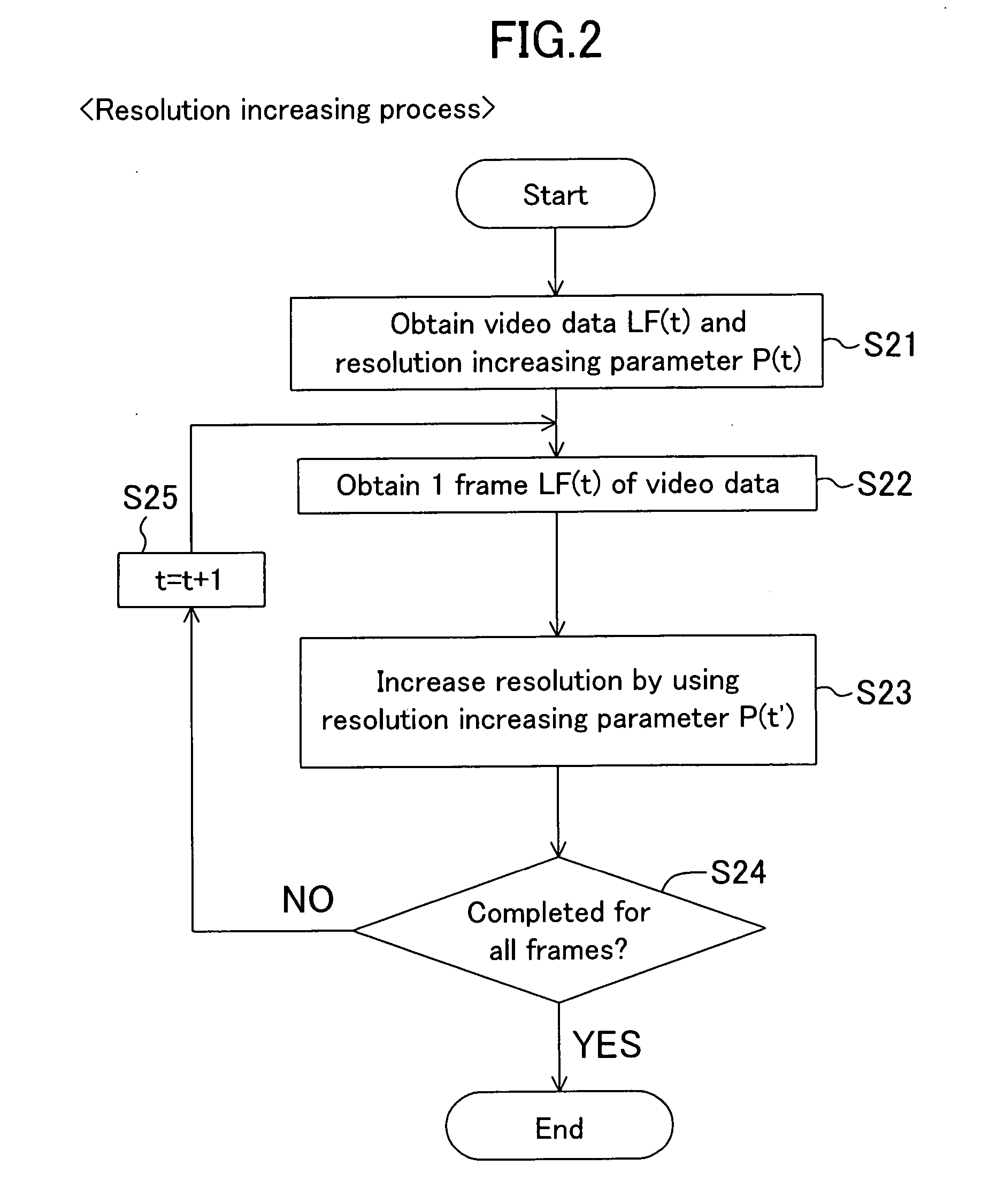Image processing method, image recording method, image processing device and image file format
a technology of image processing and recording method, applied in the field of image processing technique, can solve the problems of difficult to record video data with a high resolution every frame, equipment will consume excessive power and generate excessive heat, and it is difficult to read out all pixels at a video data frame rate of about 30 fps
- Summary
- Abstract
- Description
- Claims
- Application Information
AI Technical Summary
Benefits of technology
Problems solved by technology
Method used
Image
Examples
first embodiment
[0084]FIGS. 1 and 2 are flow charts showing an image processing method according to a first embodiment of the present invention. FIG. 1 shows a recording process of recording a scene, and FIG. 2 shows a resolution increasing process of reproducing and displaying the recorded video data. The process of FIG. 1 and that of FIG. 2 correspond to the video recording process and the reproduction process of watching the recorded video on a display, respectively.
[0085] The recording process of FIG. 1 first obtains and stores a low-resolution image LF(t) at time t(S11). At the same time, the process obtains a high-resolution image HWF(t) in a window region being a portion of the image frame (S12). Since the high-resolution image HWF(t) is only used in a later process, it does not need to be stored as video data. Based on these images LF(t) and HWF(t) of different resolutions, the process learns and stores a resolution increasing parameter P(t) as a resolution conversion rule (S13). Then, the...
second embodiment
[0112] A second embodiment of the present invention is based on the first embodiment as described above, and is directed to a specific device configuration. In this embodiment, the recording process is performed by using a camcorder including a multi-pixel-resolution image pick-up section capable of recording multi-pixel-resolution video data as described above. The multi-pixel-resolution image pick-up section is realized by using an XY address type imaging device such as a CMOS-type image pick-up sensor.
[0113]FIG. 8 is a block diagram showing an exemplary configuration of an image processing device of the present embodiment, wherein the present invention is applied to a camcorder. An image processing device 10 of FIG. 8 includes a lens 101, a multi-pixel-resolution image pick-up section 102, a low-resolution frame memory 103 for storing one frame LF(t) of low-resolution video data, a low-resolution video recording section 104 for recording low-resolution video data DLF, a high-res...
third embodiment
[0168]FIG. 23 is a block diagram showing an exemplary configuration of an image processing device according to a third embodiment of the present invention, wherein the present invention is applied to a camcorder as in FIG. 8. The configuration differs from that of FIG. 8 in that the low-resolution frame memory 103 is omitted, and a multi-pixel-resolution video recording section 401 for recording multi-pixel-resolution compressed video data DMC is provided instead of the low-resolution video recording section 104 for recording the low-resolution video data DLF. Thus, while video data with a lowered resolution is recorded in the second embodiment, image data obtained by the multi-pixel-resolution image pick-up section 102 is stored as it is in the present embodiment. By effectively using the obtained multi-pixel-resolution video data without lowering its resolution, the present embodiment aims to improve the performance of the resolution increasing process.
[0169] When the record butt...
PUM
 Login to View More
Login to View More Abstract
Description
Claims
Application Information
 Login to View More
Login to View More - R&D
- Intellectual Property
- Life Sciences
- Materials
- Tech Scout
- Unparalleled Data Quality
- Higher Quality Content
- 60% Fewer Hallucinations
Browse by: Latest US Patents, China's latest patents, Technical Efficacy Thesaurus, Application Domain, Technology Topic, Popular Technical Reports.
© 2025 PatSnap. All rights reserved.Legal|Privacy policy|Modern Slavery Act Transparency Statement|Sitemap|About US| Contact US: help@patsnap.com



